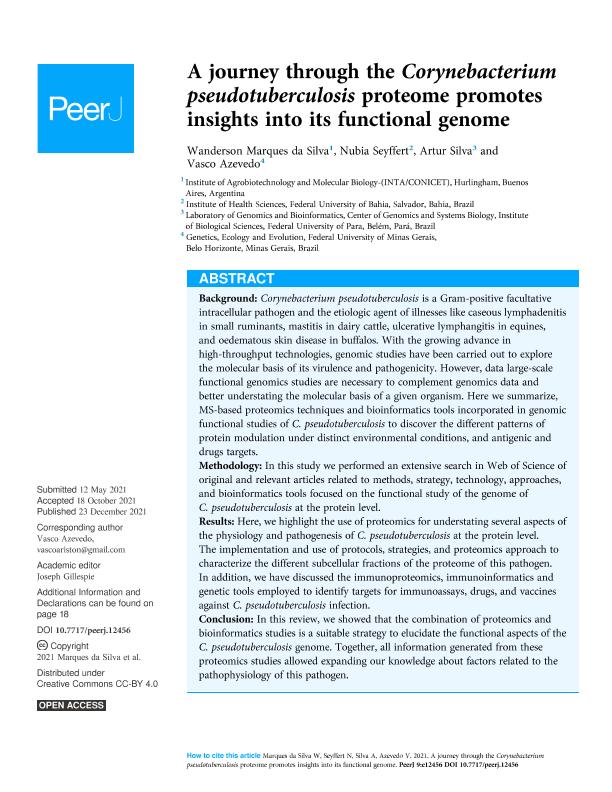Mostrar el registro sencillo del ítem
dc.contributor.author
Marques Da Silva, Wanderson

dc.contributor.author
Seyffert, Nubia
dc.contributor.author
Silva, Artur
dc.contributor.author
Azevedo, Vasco
dc.date.available
2022-08-01T13:22:33Z
dc.date.issued
2021-12
dc.identifier.citation
Marques Da Silva, Wanderson; Seyffert, Nubia; Silva, Artur; Azevedo, Vasco; A journey through the Corynebacterium pseudotuberculosis proteome promotes insights into its functional genome; PeerJ Inc.; PeerJ; 9; 12-2021; 1-31
dc.identifier.uri
http://hdl.handle.net/11336/163642
dc.description.abstract
Background: Corynebacterium pseudotuberculosis is a Gram-positive facultative intracellular pathogen and the etiologic agent of illnesses like caseous lymphadenitis in small ruminants, mastitis in dairy cattle, ulcerative lymphangitis in equines, and oedematous skin disease in buffalos. With the growing advance in high-throughput technologies, genomic studies have been carried out to explore the molecular basis of its virulence and pathogenicity. However, data large-scale functional genomics studies are necessary to complement genomics data and better understating the molecular basis of a given organism. Here we summarize, MS-based proteomics techniques and bioinformatics tools incorporated in genomic functional studies of C. pseudotuberculosis to discover the different patterns of protein modulation under distinct environmental conditions, and antigenic and drugs targets. Methodology: In this study we performed an extensive search in Web of Science of original and relevant articles related to methods, strategy, technology, approaches, and bioinformatics tools focused on the functional study of the genome of C. pseudotuberculosis at the protein level. Results: Here, we highlight the use of proteomics for understating several aspects of the physiology and pathogenesis of C. pseudotuberculosis at the protein level. The implementation and use of protocols, strategies, and proteomics approach to characterize the different subcellular fractions of the proteome of this pathogen. In addition, we have discussed the immunoproteomics, immunoinformatics and genetic tools employed to identify targets for immunoassays, drugs, and vaccines against C. pseudotuberculosis infection. Conclusion: In this review, we showed that the combination of proteomics and bioinformatics studies is a suitable strategy to elucidate the functional aspects of the C. pseudotuberculosis genome. Together, all information generated from these proteomics studies allowed expanding our knowledge about factors related to the pathophysiology of this pathogen.
dc.format
application/pdf
dc.language.iso
eng
dc.publisher
PeerJ Inc.
dc.rights
info:eu-repo/semantics/openAccess
dc.rights.uri
https://creativecommons.org/licenses/by/2.5/ar/
dc.subject
BACTERIAL PROTEOMIC
dc.subject
BIOINFORMATICS
dc.subject
CORYNEBACTERIUM PSEUDOTUBERCULOSIS
dc.subject
FUNCTIONAL GENOME
dc.subject
PROTEOMICS
dc.subject.classification
Otras Ciencias Biológicas

dc.subject.classification
Ciencias Biológicas

dc.subject.classification
CIENCIAS NATURALES Y EXACTAS

dc.title
A journey through the Corynebacterium pseudotuberculosis proteome promotes insights into its functional genome
dc.type
info:eu-repo/semantics/article
dc.type
info:ar-repo/semantics/artículo
dc.type
info:eu-repo/semantics/publishedVersion
dc.date.updated
2022-04-21T16:22:59Z
dc.identifier.eissn
2167-8359
dc.journal.volume
9
dc.journal.pagination
1-31
dc.journal.pais
Estados Unidos

dc.description.fil
Fil: Marques Da Silva, Wanderson. Instituto Nacional de Tecnología Agropecuaria. Centro de Investigación En Ciencias Veterinarias y Agronómicas. Instituto de Agrobiotecnología y Biología Molecular. Consejo Nacional de Investigaciones Científicas y Técnicas. Oficina de Coordinación Administrativa Parque Centenario. Instituto de Agrobiotecnología y Biología Molecular; Argentina
dc.description.fil
Fil: Seyffert, Nubia. Universidade Federal da Bahia; Brasil
dc.description.fil
Fil: Silva, Artur. Universidade Federal do Pará; Brasil
dc.description.fil
Fil: Azevedo, Vasco. Universidade Federal de Minas Gerais; Brasil
dc.journal.title
PeerJ
dc.relation.alternativeid
info:eu-repo/semantics/altIdentifier/url/https://peerj.com/articles/12456
dc.relation.alternativeid
info:eu-repo/semantics/altIdentifier/doi/http://dx.doi.org/10.7717/peerj.12456
Archivos asociados
